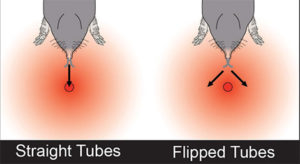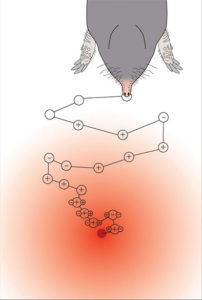 |
In the frames shown to the left, a mole emerges from a chamber while sniffing, and then quickly moves directly toward a piece of an earthworm. There is no sent trail in the arena, thus the mole navigates using the odor gradient emminating from the earthworm. The same ability is seen under infrared illumination. (Movie) |
 |
As would be predicted for a stereo system, blocking a single nostril causes the animal to veer off in the direction of the open nostril when approaching odor sources. Movie |
 |
Flipping the nostrils with tubes causes repulsion from the odor. This is because any deviation from a direct course is amplified. For example when on the right of the odor, the left nostril is most stimulated, but when on the left of the odor, the right nostril is most stimulated. Movie |
 |
Stereo sniffing cues are only part of the mole’s olfactory toolkit. They also use more conventional “serial” sniffing cues at the same time, which allow them to overcome the effect of nostril block to locate odors. Serial sniffing cues likely provide the information moles use to orient from longer distances where the odor gradient is less steep. In contrast, stereo sniffing cues are most likely important at short distances. The schematic at the left illustrates the hypothetical combined use of stereo and serial sniffing. |
|
Click here for a recent paper (with movies) covering this research. |

